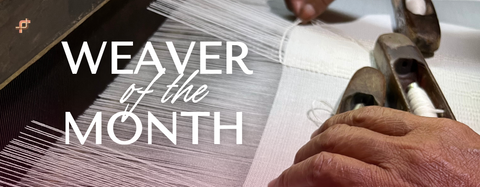Iloilo has a reputation of creating all kinds of beautiful weaves, but one particular weave is so iconic that it has inspired generations of weavers, designers, and artisans. That weave is the hablon, which has become one of Iloilo’s signature weaves.
However, despite being so important, the hablon has also gone through highs and lows over the past few decades. It is now just starting to regain its popularity – both in the Philippines and abroad.
Today, we’ll be diving into what exactly makes a hablon weave, as well as the history and culture that are carried by every thread.

What Is Hablon?
Hablon is a handwoven textile from Iloilo traditionally made with a handloom using natural fibers such as abaca, piña, and cotton. The term hablon comes from the Hiligaynon word “habol”, which means “to weave”, and it can be used to describe both the process of weaving and the fabric itself.
Because of its beautiful designs, Iloilo hablon has been sourced by designers all over the world. It is typically used to create high-quality apparel, including shawls, patadyong (wraparound skirt), and formal wear such as gowns.

Hablon Weaving in Iloilo

Hablon weaving had already been established in Iloilo before the Spaniards arrived in the 16th century, observing that the region was a big supplier of cotton and other textiles.
By the 19th century, Iloilo was known as the “textile capital of the Philippines” with a thriving industry that produced fabric for the local and international markets. The towns of Miagao, Oton, Igbaras, Badiangan, and Dueñas in particular have a rich hablon weaving history.

National Museum Western Visayas “Habol Panay: The Woven Artistry of Western Visayas” exhibition features the weaving traditions of Region 6.
However, as machine-woven textiles became popular, there was a decline in the demand for handwoven textiles like hablon. At the same time, handloom parts were harder to come by, making it hard for weaver communities to repair their looms. By the 1980s weavers were forced to switch to other professions to make a living.
Thankfully, things took a turn for the better in the early 2000s, when the Iloilo government joined forces with the Department of Tourism to revive the industry. Through the efforts of local artisan communities, the hablon textile is now reaching even higher heights of fame all over the world.

We also feature the stories of our partner hablon weavers in Weaver of the Month, highlighting their personal journey and exploring their role in the weaving community.
How Is Hablon Made?
Before the weaving process begins, the materials for hablon weaving are prepared by the artisans. These consist of yarn, which are traditionally made from cotton, abaca, and piña. With the rise of cheap hablon materials, polyester has also become popular – despite having a greater impact on the environment.
To make hablon, weavers first pick and arrange yarn to create the desired pattern. The yarns are then set up on the warping frame and passed through the heddle, which guides the yarns during the weaving process.

Each yarn is then inserted through an opening in a metal reed and tied to the cloth roll, which is the wooden cane at the base of the loom. Once the handloom is set up, the weft yarn is spooled onto the shuttle with a spooling wheel.
The weaver then uses the bamboo pedal to raise and lower the heddle, propelling the weft across the loom with the shuttle. Finally, the weft is pushed by the reed, and the process repeats until the hablon weave is completed.
Related: A closer look at the handloom weaving process
What Kinds of Hablon Fabric Products Are There?
In terms of the direct result of hablon weaving, the end-products include fabric, shawls, and sashes. Apparel, such as office uniforms, can then be made from hablon cloth.
Due to the pandemic, face masks have also become a popular hablon product, allowing wearers to stay healthy and showcase their culture at the same time.

Hablon is also in-demand when it comes to modern fashion. It is used by designers worldwide as a statement fabric that stands out in terms of aesthetic, texture, and quality.

This contemporary Filipiniana top from the Lin.ay collection is embroidered with the Hiligaynon word "Lin-ay" meaning "goddess" or "lady".
Where to Buy Hablon in Iloilo
Now that you know all about this wonderful weave, you’re probably wondering where to buy hablon in Iloilo.
When it comes to apparel, you can buy from Iloilo-based designers like Binky Pitogo, who co-designed her Lin-ay collection with Panublix. (Related article: Designing Modern Filipiniana with Binky Pitogo)
And if you’re a creative looking to use hablon fabric, Panublix offers Iloilo Cotton Hablon for your design needs. Locally-sourced and consciously-made, the hablon is handwoven by our partner weavers in Iloilo.
Shop Iloilo Hablon Fabric
By promoting hablon fabric made from natural fibers, Panublix aims to bring back the use of tropical textiles – and effectively steer the fashion industry in a direction that conserves both our culture and environment.
In line with this mission, we provide partner weavers with access to tropical yarns and digital economy support.
→ Learn more about our commitment to impactful sourcing in the Panublix annual report.
→ Read the stories of our partner artisans in Weaver of the Month.
---
References:
“Habol Panay Gallery - National Museum.” National Museum, www.nationalmuseum.gov.ph/exhibitions/nm-western-visayas-regional-museum/habol-panay-gallery. Accessed 8 Nov. 2022.
Funtecha, Henry F. “The Hablon Industry in Iloilo: Fame and Decline.” The News Today, www.thenewstoday.info/2008/05/09/the.hablon.industry.in.iloilo.fame.and.decline.html. Accessed 8 Nov. 2022.
Villareal, Melo. “The Art of Hablon Weaving in Iloilo.” Out of Town Blog, 9 May 2019, outoftownblog.com/the-art-of-hablon-weaving-in-iloilo.



